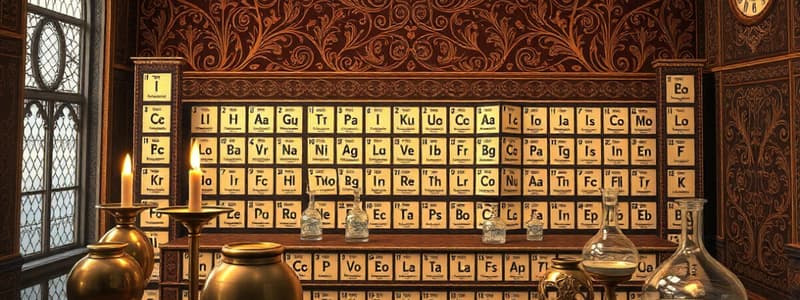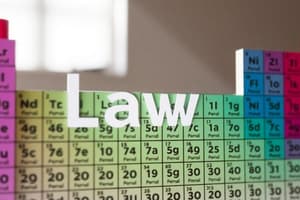Podcast
Questions and Answers
What was one significant impact of Mendeleev’s Periodic Law on scientific research?
What was one significant impact of Mendeleev’s Periodic Law on scientific research?
- It led to the discovery of the first transuranium elements.
- It caused chemists to abandon the concept of elemental families.
- It influenced the study of radioactive decay series for uranium and thorium. (correct)
- It resulted in the immediate identification of all existing elements.
Why did Mendeleev leave gaps in his Periodic Table?
Why did Mendeleev leave gaps in his Periodic Table?
- To illustrate his predictions about elements that would be discovered in the future. (correct)
- To indicate that the Periodic Table was incomplete and required refinement.
- To represent elements that were already discovered but not yet classified.
- To make the table visually appealing and organized.
What achievement is attributed to Glenn T. Seaborg in relation to Mendeleev?
What achievement is attributed to Glenn T. Seaborg in relation to Mendeleev?
- He developed the modern version of the Periodic Table.
- He discovered the first noble gas, helium.
- He proposed naming element 101 as Mendelevium. (correct)
- He organized the first classification of transuranium elements.
What was one of Mendeleev's roles after resigning from his Professorship?
What was one of Mendeleev's roles after resigning from his Professorship?
What was unknown to chemists at the time Mendeleev developed his Periodic Table?
What was unknown to chemists at the time Mendeleev developed his Periodic Table?
What property was noted by Johann Dobereiner in his Law of Triads?
What property was noted by Johann Dobereiner in his Law of Triads?
Who is credited with the development of the Periodic Law as we know it today?
Who is credited with the development of the Periodic Law as we know it today?
What was the main limitation of Newlands’s Law of Octaves according to the document?
What was the main limitation of Newlands’s Law of Octaves according to the document?
Which element grouping did Dobereiner focus on in his studies?
Which element grouping did Dobereiner focus on in his studies?
What type of properties did Lothar Meyer plot to classify elements in 1869?
What type of properties did Lothar Meyer plot to classify elements in 1869?
Flashcards are hidden until you start studying
Study Notes
Early Attempts to Classify Elements
- Johann Dobereiner (early 1800s) observed similarities in properties of elements in groups of three (Triads), where the middle element's atomic weight was approximately halfway between the other two.
- Law of Triads was dismissed as coincidental due to its limited application.
- A.E.B. de Chancourtois (1862) attempted to classify elements based on increasing atomic weights, proposing that similar properties recur at regular intervals.
Mendeleev’s Periodic Law and The Periodic Table
- Dmitri Mendeleev (1834-1907) and Lothar Meyer (1830-1895) independently proposed the Periodic Law in 1869.
- Periodic Law: Elements arranged in increasing order of atomic weight exhibit recurring similarities in their physical and chemical properties.
- Mendeleev left gaps in his Periodic Table to accommodate undiscovered elements, predicting their properties based on trends.
- Discovery of Noble Gases: Helium and Argon (1890), followed by Krypton and Xenon, expanded the Periodic Table and led to the creation of a new group.
- Radioactive decay series: The study of uranium and thorium in the early 20th century was guided by the Periodic Table.
Modern Periodic Law and The Present Form of The Periodic Table
- Mendeleev's table was developed before the understanding of atomic structure.
- Modern periodic law states that the properties of elements are periodic functions of their atomic numbers.
- The modern Periodic Table is arranged based on the increasing atomic number of elements.
Trends in Physical and Chemical Properties
- Metallic character: Generally increases down a group and decreases from left to right across a period.
- Non-metallic character: Increases from left to right across a period and decreases down a group.
- Ionization enthalpy: Increases across a period due to increasing nuclear charge and decreases down a group due to increasing shielding effect.
- Electron gain enthalpy: Negative for many elements, indicating energy release during electron gain.
Studying That Suits You
Use AI to generate personalized quizzes and flashcards to suit your learning preferences.




